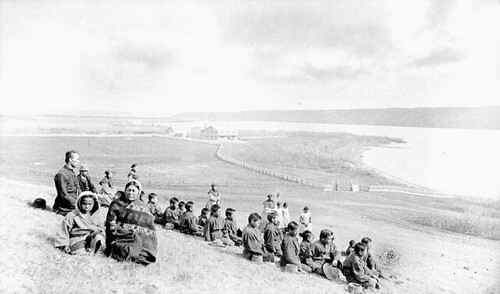Canada is to pay more than $2bn to settle a lawsuit seeking compensation for harm to Indigenous languages and cultures.
Canada will pay more than $2bn to hundreds of Indigenous communities to settle a lawsuit seeking compensation for the loss of language and culture caused by residential schools, the government has announced.
The class action lawsuit by 325 Indigenous groups ended with the settlement of 2.8 billion Canadian dollars ($2.1bn United States) which will be placed in a trust fund independent of the government.
It will be used to “revitalize Indigenous education, culture, and language – to support survivors in healing and reconnecting with their heritage,” according to a government statement.
The precise terms for disbursing the $2.1bn are yet to be approved by the federal court.
The Canadian government sent about 150,000 children into 139 residential schools from the late 1800s to the 1990s. The institutions were mostly run by the Catholic Church, and during their time there, Indigenous children were cut off from their families, language and culture.
Many children were also physically and sexually abused, with thousands believed to have died of disease, malnutrition or neglect.
“It has taken Canada far too long to own up to its history, own up to the genocide it committed and recognize the collective harm caused to our nations by residential schools,” said Garry Feschuk, an Indigenous leader who is one of the plaintiffs in the suit.
“It is time that Canada not only recognize this harm, but help undo it by walking with us. This settlement is a good first step,” he said in a statement released on Saturday.
Over the past two years, there have been discoveries of thousands of unmarked graves at the former schools that put the spotlight on Canada’s dark colonial past. More than 1,300 graves have been identified.

Earlier this month, ground-penetrating radar uncovered nearly “2,000 areas of interest” that need to be thoroughly investigated in Lebret, Saskatchewan, the Star Blanket Cree community said.
A fragment of a child’s jawbone dating to some 125 years ago has already been identified on the grounds of a former residential school in the western Canadian community.
“The residential school system decimated our languages, profoundly damaged our cultures, and left a legacy of social harms. The effects go beyond my generation. It will take many generations for us to heal,” said Shane Gottfriedson, another Indigenous leader and plaintiff.
“We believe that all survivors deserve justice and the compensation to which they are owed,” said Marc Miller, federal minister of Crown-Indigenous Relations, in the press release.
A national commission of inquiry in 2015 called the residential school system a “cultural genocide”.
Hundreds of people protested, demanding an independent investigation into the “residential schools” that Indigenous children were forced to attend.
Last year, the Catholic Church’s Pope Francis visited Canada on a penitential trip during which he apologised to Indigenous people for the “evil” of residential schools, the church-run, forced-assimilation institutions that First Nations, Inuit and Metis children were made to attend for decades.
SOURCE: AL JAZEERA


